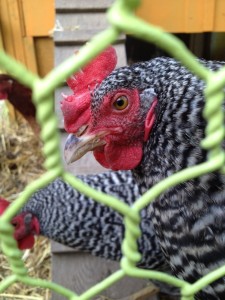Less energy: Backyard chickens!
 And we have a winner from the chicken coop design giveaway at the recent Seattle Green Home Tour. The LemonDrop Addition was on the tour and there were a couple of chicken-related events – both a raffle to win a custom chicken coop design as well as a live green roof installation on the roof of the chicken coop. Thanks to landscape design Keri DeTore for the installation of the green roof!
And we have a winner from the chicken coop design giveaway at the recent Seattle Green Home Tour. The LemonDrop Addition was on the tour and there were a couple of chicken-related events – both a raffle to win a custom chicken coop design as well as a live green roof installation on the roof of the chicken coop. Thanks to landscape design Keri DeTore for the installation of the green roof!
Here are some images of the chicken coop green roof in process. It was a great way to see the parts and pieces of the roof design. As with most green roofs, there were several layers to the roof. First, a waterproof roof membrane that is impervious to root penetration. In the “low-tech” chicken roof version, this was a rubber pond liner, while the green roof on the LemonDrop Addition is a professionally installed, fully adhered commercial rubber roof membrane. Next is a drainage mat, which is a product designed specifically for green roofs that serves to retain moisture, but also to allow it to drain freely off the roof to avoid ponding. It is covered with a landscape fabric that keeps the soil from passing through, so that the system doesn’t get clogged up. We happened to have just enough left over from the green roof installation on the house.
 After that comes the planting medium – I am careful not to call it dirt because it is pretty far from what you would typically consider appropriate for planting. This mixture was about 60% perlite, 10% sand, 10% pumice, and 20% compost. The goal is to have primarily mineral materials, so that the planting medium will not decompose and disappear over time. For the main green roof we were able to special order the soil mixture to our green roof consultant’s specifications, but the chicken coop roof was too small for that to make sense. And of course, the plants! It is important to pick plants that have a shallow root system and that can survive extreme moisture and extreme drought conditions. Here’s a group of sedums that went on the roof, and there were also grasses, thyme, and kinnickinnick.
After that comes the planting medium – I am careful not to call it dirt because it is pretty far from what you would typically consider appropriate for planting. This mixture was about 60% perlite, 10% sand, 10% pumice, and 20% compost. The goal is to have primarily mineral materials, so that the planting medium will not decompose and disappear over time. For the main green roof we were able to special order the soil mixture to our green roof consultant’s specifications, but the chicken coop roof was too small for that to make sense. And of course, the plants! It is important to pick plants that have a shallow root system and that can survive extreme moisture and extreme drought conditions. Here’s a group of sedums that went on the roof, and there were also grasses, thyme, and kinnickinnick.

 When space in your yard allows, it is a wonderful treat to have chickens – a good source of eggs and entertainment. The use of very locally grown food also reduces the amount of energy used to raise and transport the eggs to your supermarket. And many people believe that home-grown eggs are healthier, or at the very least fresher and more delicious.
When space in your yard allows, it is a wonderful treat to have chickens – a good source of eggs and entertainment. The use of very locally grown food also reduces the amount of energy used to raise and transport the eggs to your supermarket. And many people believe that home-grown eggs are healthier, or at the very least fresher and more delicious.




